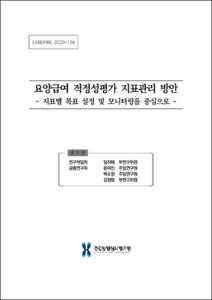요양급여 적정성평가 지표관리 방안 -지표별 목표 설정 및 모니터링을 중심으로
- Type
- Research report
- Issued Date
- 2020-11
- Keyword
- HIRA; Health Insurance Review & Assessment; Quality Assessment in Healthcare Benefits; Quality Goal Setting; Monitoring of Measure; Measure Lifecycle; Measure Management
- Abstract
- The focus of quality assessment has shifted from healthcare service use to clinical quality improvement. As of September 2018, the quality assessment in Korea examines 34 items with 408 measures. While quality assessment has expended in quality and quantity, the validity and confidence in assessment measures has decreased, affecting assessment efficiency negatively. In response, the Health Insurance Review & Assessment Service (HIRA), carried out a reshuffle of assessment measures from 2016 to 2019. Nevertheless, there is a lack of the measure lifecycle through measure development, implementation, maintaining, and retire. Against this backdrop, this study was designed to contemplate measure management based on effectiveness analysis of existing measures.
For this study, 16 items were selected as target with measure that were continuously used 3 to 4 times in quality assessment as of 2019. The measurement type was analyzed for each measure, and distribution was observed based on descriptive statistics values, including average, standard deviation, applicable quartile, and minimum and maximum. Using AHRQ analysis of the U.S. and QOF analysis of the U.K., 95% performance achievement rate and average yearly fluctuation rate were analyzed.
Results showed that there were ratio measures, case number measures, yes/no measures, and other measures. Among the 16 items, 79.49% were ratio measures, which was considered the most universal and suitable type to monitor achievement rate and average yearly fluctuation. As such, when AHRQ and QOF analysis were applied to ratio measures, most results were over 95% achievement rate, proving some level of quality improvement. Other measures were not suitable to use for performance achievement rate.
Based on the analysis results, following suggestions were proposed for management of quality measures. Most measures does not come with a quality goal when measure development. To establish a measure lifecycle, there are five steps to follow: Step 1) the measure should be reviewed upon type of measurement, meaning of measures, and objective of measurement, Step 2) analysis method should be selected for the measure, Step 3) the results need to be analyzed, Step 4) validity of the measure should be reviewed, and Step 5) the type of measure management (maintaining, improvement, monitoring, retirement) should be decided. Also, for measures that are relatively new to assessment, the result of first assessment can be used as a benchmark for goal setting for next iteration.
In conclusion, this study did not succeed in suggesting goal setting methods for existing measures, but it did propose a monitoring method based on assessment results. Form now on, newly developed measures should come with a goal and management frequency, and measure validation process needs to be added. To that end, a measure lifecycle should be put in place. Furthermore, a group of experts who contribute direction and thoughtful input to the measure development process requires to be formed to improve measure management and secure objectivity in operation.
- Publisher
- 건강보험심사평가원
- Alternative Title
- Quality assessment measure management: focusing on quality goal setting and monitoring of existing measures
- Table Of Contents
- 요 약 ⅰ
제1장 서론 -------------------------------- 1
1. 연구의 배경 및 필요성 -------------------------------- 1
가. 적정성평가 지표의 현황 -------------------------------- 1
나. 적정성평가 지표관리와 문제점 -------------------------------- 4
다. 연구의 필요성 -------------------------------- 7
2. 연구의 목적 -------------------------------- 8
3. 연구의 내용 및 방법 -------------------------------- 8
제2장 외국의 질 지표관리 현황 -------------------------------- 11
1. 미국 -------------------------------- 11
가. AHRQ의 질 지표관리 -------------------------------- 11
나. CMS의 질 지표관리 시스템 -------------------------------- 19
다. NQF의 질 지표 평가 기준 -------------------------------- 22
라. CHIP의 질 지표관리 -------------------------------- 26
2. 영국 -------------------------------- 30
가. QOF의 개요 -------------------------------- 30
나. QOF의 지표 평가 방법 -------------------------------- 33
3. 소결 -------------------------------- 37
제3장 요양급여 적정성평가 지표 분석 -------------------------------- 43
1. 적정성평가 지표 분석 개요 -------------------------------- 43
가. 분석 대상 항목 선정 -------------------------------- 43
나. 적정성평가 지표 분석 -------------------------------- 45
2. 적정성평가 지표 분석 결과 -------------------------------- 47
가. 급성기 질환 평가 영역 -------------------------------- 47
나. 만성기 질환 평가 영역 -------------------------------- 62
다. 진료행위 및 약제 평가 영역 -------------------------------- 77
라. 정신건강 평가 영역-의료급여정신과 -------------------------------- 95
마. 기관단위 평가 영역-요양병원입원급여 -------------------------------- 99
3. 소결 -------------------------------- 105
제4장 요양급여 적정성평가 지표관리 방안 -------------------------------- 109
1. 지표관리에 대한 전문가 의견 -------------------------------- 109
가. 지표 평가를 위한 추가 방법 검토 -------------------------------- 109
나. 지표분석 결과에 대한 의견 -------------------------------- 110
2. 적정성평가 지표관리를 위한 방법 모색 -------------------------------- 114
가. 지표의 유형에 따른 관리 방법 -------------------------------- 114
나. 지표의 의미에 따른 관리 방법 -------------------------------- 122
다. 지표의 측정 목적에 따른 관리 방법 -------------------------------- 125
3. 적정성평가 지표관리 방안 마련 -------------------------------- 126
가. 기존 지표의 관리 방안 -------------------------------- 126
나. 신규지표 도입시 관리 방안 -------------------------------- 132
4. 소결에 대신하여 – 한국형 지표생애관리 체계 제안 -------------------------------- 133
제5장 결론 및 제언 -------------------------------- 139
참고문헌 -------------------------------- 143
ABSTRACT -------------------------------- 147
부 록 -------------------------------- 149
- Publisher
- 건강보험심사평가원
- Location
- KOR
- Citation
- 임지혜 et al. (202011). 요양급여 적정성평가 지표관리 방안 -지표별 목표 설정 및 모니터링을 중심으로.
- 파일 목록
-
-
Download
 요양급여 적정성평가 지표관리 방안.pdf
기타 데이터 / 3.36 MB / Adobe PDF
요양급여 적정성평가 지표관리 방안.pdf
기타 데이터 / 3.36 MB / Adobe PDF
-
Items in Repository are protected by copyright, with all rights reserved, unless otherwise indicated.